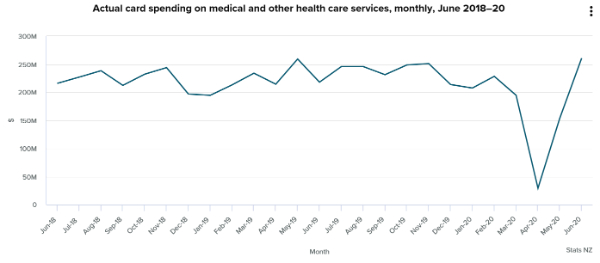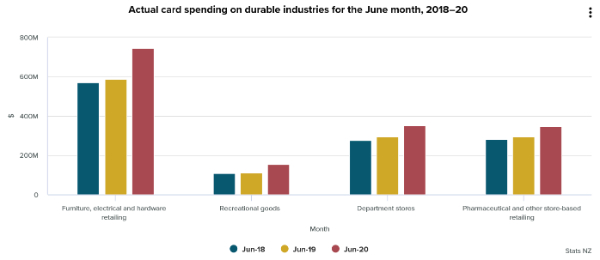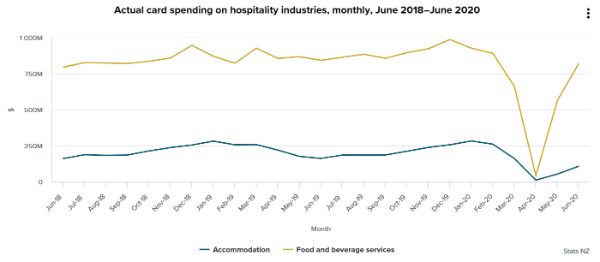Health Care Spending Revives In June
Monthly card spending on medical and other health care services reached a record high in June 2020, Stats NZ said today.
In actual terms, spending on medical and other health care services was $261 million in June 2020, up 20 percent ($43 million) from June 2019.
Health care services include GPs, specialists, physiotherapy, optometry, ambulances, and dental care.
“New Zealanders couldn’t make face-to-face health care visits during lockdown, so they had to wait until June to return to doctors, dentists, and other specialists,” retail statistics manager Kathy Hicks said.
“Spending on health care services during the level-4 lockdown in April was almost non-existent. However, there was a slight recovery in May as we moved through alert levels 3 and 2,” Ms Hicks said.

Furniture, hardware, and other long-lasting goods
Spending on long-lasting goods (ranging from furniture to cosmetics) continued to rise in June, following a bumper May.

In actual terms, all four durables industries reached record highs for any June month. Furniture, electrical, and hardware retailing had the largest dollar value increase, up $159 million (27 percent) from June 2019.
“The increase in spending on long-lasting goods could still be the effect of pent-up demand following alert levels 3 and 4, when retailers were mostly shut,” Ms Hicks said. "New Zealanders might have been using the wider shopping options on offer at COVID-19 alert levels 2 and 1 to buy equipment to help them work better from home or hardware for do-it-yourself jobs."
Eating out recovers, but accommodation still relatively low
“Restricted border measures continue to impact hospitality, with accommodation affected more than restaurants, bars, and takeaways,” Ms Hicks said.

Spending at restaurants, cafes, and takeaways (food and beverage services) is nearly back up to pre-COVID-19 levels but is still down 2.4 percent on the June 2019 level.
Spending on accommodation, including hotels, motels, and camping grounds, is still at low levels, down 33 percent on June 2019. This reflects the lack of international visitors as a result of COVID-19.
See Electronic card transactions: June 2020 for more information and to download data.


 Stats NZ: Retail Spending Flat In The September 2024 Quarter
Stats NZ: Retail Spending Flat In The September 2024 Quarter Antarctica New Zealand: International Team Launch Second Attempt To Drill Deep For Antarctic Climate Clues
Antarctica New Zealand: International Team Launch Second Attempt To Drill Deep For Antarctic Climate Clues Vegetables New Zealand: Asparagus Season In Full Flight: Get It While You Still Can
Vegetables New Zealand: Asparagus Season In Full Flight: Get It While You Still Can  Bill Bennett: Download Weekly - How would NZ telecoms cope with another cyclone
Bill Bennett: Download Weekly - How would NZ telecoms cope with another cyclone NZ On Air: Firm Audience Favourites Lead NZ On Air Non-Fiction Funding
NZ On Air: Firm Audience Favourites Lead NZ On Air Non-Fiction Funding Insurance and Financial Services Ombudsman: Woman Gets $40k More After Disputing Insurer’s Decision
Insurance and Financial Services Ombudsman: Woman Gets $40k More After Disputing Insurer’s Decision



